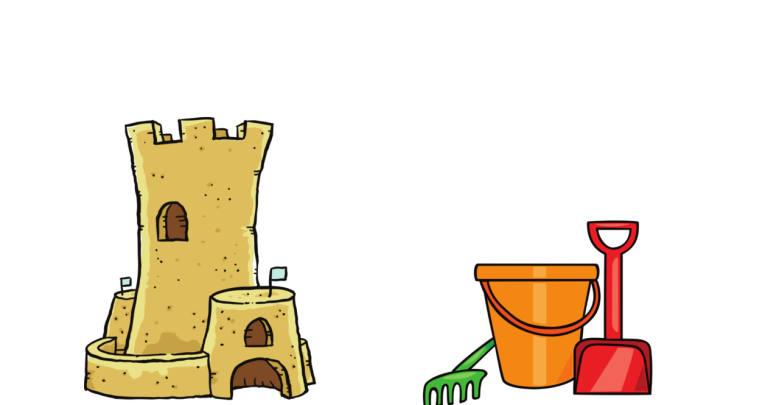13 Multisensory Ways To Supercharge Your Sand Play

Don’t settle for the traditional buckets and spades – get kids flocking to the tray indoors and out with these creative ideas from Kirstine Beeley

- by Kirstine Beeley
- Early years training consultant with 20 years of experience Visit website

Whether it’s creative ideas, sensory experiences or ways to develop fine-motor skills, Kirstine Beeley has it all covered:
Creative resources
Stretchy socks Adding socks of all sizes and colours to your indoor or outdoor sand adds an extra open-ended dimension that can lead to lots of exploration, questioning and problem-solving. Children are able to work together to fill the socks and then to experience first hand concepts such as length, size, weight and capacity as they play. How can we make the socks longer? Who has the smallest sock? Can you fill your sock to the top? Include different designs to create great opportunities to explore alliteration: “Super, stretchy, soggy, spotty socks in sand!” anyone?
Treasure to measure Apart from their colour, sand-play staples such as plastic containers, buckets, scoops and spades offer very little of the sensory stimulation required to build early brain connections. Introducing metal and wooden containers provides an extra sensory dimension, as well as plenty of chances to explore maths language. The treasure-like nature of metal containers acts as a prompt for imaginative talk and story play, too. You can pick up brass, copper and steel jugs, pots, cups and kettles cheaply if you scour charity shops, car boot sales and online auctions.
Super-sized tools The outdoors affords you space to explore concepts unsuited to indoors. Adding large-scale equipment to your sand area gives children the chance to experience many of these – for example, big builders buckets and snow shovels allow children to feel what ‘heavy’ really means, while working together to move a full tub of sand develops problem-solving skills. Using large garden sieves to find treasure (plastic pirate coins or jewels) helps to build coordination and the gross motor skills essential for early pre-writing. Making it big really does build bodies and minds!
Sensory exploration
Sand mousse Adding a squirt of washing-up liquid and some warm water to sand makes a mousse-like sand that offers a sensory experience that will really stimulate brain development and first-hand exploration of materials. Children will love squishing and mark making in the mousse as they develop the language to describe what they are feeling and extend their sense of touch. Powder paint can be added to make swamps for dinosaurs or mud mousse for monsters during the development of small world story-building adventures.
Mixing colours Taking a zip-lock bag of dry sand and adding a spoon of powder paint, then mixing and shaking it results in a lovely coloured sand that can be used to mix, pour and mark-make (the colouring will come off on children’s fingers as they play, leading to even more language and communication). Add paint brushes and combs to make lots of patterns in the sand, or spoons and clear containers for fine motor scooping and filling. A cheap and enjoyable exploration of colour mixing to stimulate the sense of sight.
Scented sand Adding various ‘smelly’ elements to your sand will give everyday scooping and pouring an extra dimension. Why not try adding lavender to the sand? Or fruit tea leaves, dried herbs and spices (cinnamon sand is a favourite of mine and is great for deterring bugs and insects outdoors!) or food flavourings such as lemon or peppermint essence, or even cocoa powder for chocolate-smelling sand? All of these smells are safe and work well with both wet and dry sand. Try not to use essential oils as these are too strong for young skin, and always check for allergies and sensitivities.
Fine motor fun
Squidge it Changing the consistency of sand helps to give it extra interest. Adding cornflour to wet sand (two parts sand to one part cornflour) gives you a mouldable sand (or ‘moon sand’) that’s great for squeezing and building up the fine motor muscles in little hands essential for early writing. Using jelly moulds in a variety of shapes and sizes allows for an element of creativity as well as encouraging plenty of problem-solving as children play.
Pour it To build early coordination and motor skills children need lots of ways to pour and scoop, so providing a variety of scooping tools is vital. Clear sweet scoops are an affordable solution and can be found in the wedding section of household stores. Collect a selection of metal spoons of different shapes, sizes and lengths to create opportunities for maths language to be incorporated into play.
Try getting parents to collect scoops from baby milk and washing powder containers, too. Having something fun to scoop into is always fun, and paper sweet bags from online auctions are always popular, as are cardboard tubes, scallop shells and gift boxes.
Mark it Exploring dry sand with mark-making tools such as paint brushes of all sizes, sticks and combs gives children the chance to develop their pattern-making abilities, including essential left-to-right patterns, anticlockwise circles and top-to-bottom lines (all part of the foundations of early letter formation). Using a thin layer of dry sand on a mirror affords an added sensory element to this play, while placing the sand on patterned wrapping paper will encourage children to move it and explore it with their tools.
Something different
Messy sawdust There are many, many alternatives to sand that you and your children might like to try in the sand tray. Try adding sawdust (remember to get the clean pet version), for example – it’s a great scooping and filling alternative and smells really nicely of wood. After exploring it dry, you can add water to facilitate mixing and squishing, an enjoyable multisensory messy play experience for children. Other dry alternatives that work well when water is added include porridge oats, cereals and flour.
Rainbow rice Coloured rice offers a fun way of engaging children in scooping, pouring and filling. To make it, place your dry rice in a zip-lock bag, then add a blob of hand sanitising gel and some gel food colouring. Close the bag and move the rice around until it is completely covered. Open the bag and leave it to dry for a few hours, then repeat with extra colours. Provide the children with bags, clear containers and scoops to create an engaging, multisensory fine motor activity.
Weights and measures Lots of different substances can be added to your sand tray to encourage children to scoop, pour and explore the language of maths involved in size, weight and capacity.
Try adding red lentils (be careful not to get them wet or they may start to sprout!), dried beans and pulses (try painting butter beans or dying chick peas with food colouring for added interest), alphabet spaghetti, pearl barley, rice cereal and sunflower seeds – they all offer different possibilities. Alternatively, why not try filling your tray with bird seed (check for nuts and nit allergies) or compost?
Turn to the tray
The process of pouring, scooping, filling and building structures with sand is a staple of early years settings and offers play-based access to a host of learning opportunities, amongst them the exploration of maths, literacy and science language.
By tweaking just a few elements you can enhance the play possibilities and therefore extend the learning potential. Playing with sand is great fun outdoors and in, and offers a magical introduction to fine motor development and essential early mark making skills. It’s not just a sensory play possibility but a vital element of early play provision.
Tip Try adding red lentils, dried beans and pulses, alphabet spaghetti, pearl barley, rice cereal and sunflower seeds – they all offer different possibilities.
Kirstine Beeley is co-author of 50 Fantastic Things to do with a sand tray and has lots of additional ideas on her pinterest page – visit pinterest.com/kirstinebeeley.










